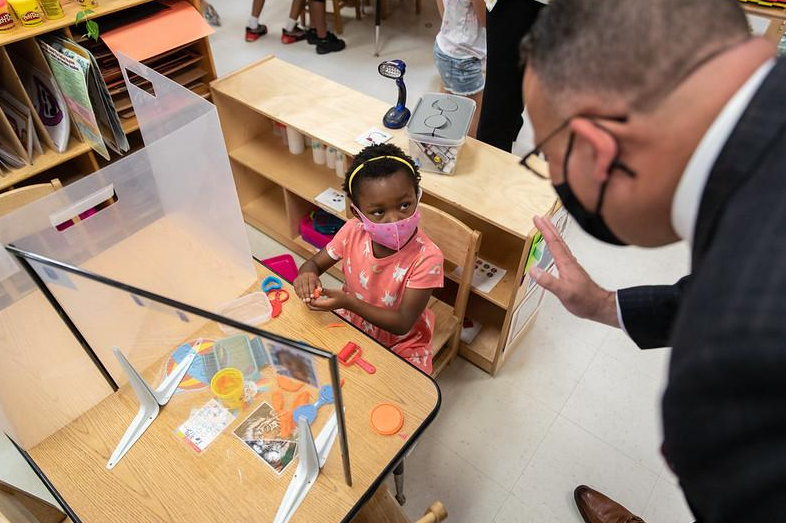
4 Tips for Covering the Recovery of the Child Care Industry
Mindful approaches to reporting on early education and child care.
Photo credit: U.S. Department of Education

Mindful approaches to reporting on early education and child care.
Photo credit: U.S. Department of Education
The Biden administration’s ambitious plan to expand access to free universal preschool, increase the wages of child care providers to at least $15 an hour, and make child care more affordable for families sent ripples of optimism through the child care industry when unveiled this spring.
This is “an opportune time for child care,” said Katie Hamm, the acting deputy assistant secretary for early childhood development at the U.S. Department of Health and Human Services, during a virtual panel on the subject at the 2021 Education Writers Association’s National Seminar. Hamm noted that it was the pandemic crisis that led to this moment.
“It has finally pushed us to a place where there is so much more awareness of what the child care sector needs to recover,” she said, “and what the structure was that made child care so precarious (before) the pandemic.”
Child care centers have struggled during the pandemic due to lower enrollment, staff attrition and reduced capacity for available seats, putting a strain on working parents who rely on this service.
The $1.9 trillion stimulus plan that President Biden signed in March provides $39 billion in child care relief funds, including $24 billion for child care stabilization grants and $15 billion in supplemental funds.
The Biden administration also has proposed a $1.8 trillion “American Families Plan” designed more as a long-term solution. This wide-ranging initiative includes spending increases and tax credits to make quality child care and early education – as well as community college – more affordable. However, the political prospects for this proposal are uncertain, given GOP opposition in a closely divided Congress.
During the EWA panel, moderated by The Hechinger Report’s Jackie Mader, experts said inadequate pay for the child care workforce is one of the biggest barriers to expanding access to early learning.
“Working in child care is not just a low-wage job, it’s one of the worst paid jobs in America,” with employees earning $11.65 an hour on average in 2019, said Caitlin McLean, a senior research specialist at the Center for the Study of Child Care Development at the University of California, Berkeley.
McLean said child care workers often risked their own health and safety by working through the pandemic, typically without health insurance or paid sick leave. She emphasized the importance of providing direct cash payments to providers with the federal relief aid.
“We need to keep teachers in classrooms, and they need financial support in order to do that,” McLean said.
For reporters covering child care, early education and the impact of federal plans for this industry, the panelists offered several tips:
Rochelle Wilcox, the CEO and executive director of New Orleans-based Wilcox Academy of Early Learning, reminded reporters to remember the youngest children when covering early learning.
“Children are not born at 4,” she said. “I hear a lot about preschool, but we want to make sure we are covering our infants and toddlers.”
Wilcox said it’s the youngest children who are the most vulnerable learners, and 80% of what kids learn, they learn before age 3. However, it’s the children under this age who are “often left behind and not talked about” in story coverage.
A large disparity exists in pay across the child care educator workforce, with Black employees paid 78 cents less per hour than white employees, McLean said. Reporters should “recognize the racist and sexist underpinnings of the child care system,” she said, and shed light on this issue in their coverage.
Along those lines, Wilcox said it’s important to recognize the “true cost” of a quality early education and to put that in perspective. For instance, in Louisiana, she said, tuition per year for a center-based infant child care spot is roughly $9,100, but the true cost due to increased expenses is closer to $20,000. In a state where the median annual salary is $41,000, that means a parent could be spending half their salary on early child care.
“No one can survive off that,” Wilcox said.
Panelists urged reporters to talk directly to child care providers, teachers and owners of small businesses to “really understand the perspective of people who are doing this work.”
Also, find out who’s “sitting at the table when decisions are made” when it comes to the distribution of federal relief funds, Wilcox said. Are there focus groups, for instance? How will the funding plans be implemented? And how do state officials plan to get these funds into the hands of those who need it the most?
“There are a lot of great ideas, but once it gets down to the providers, is it something that will actually work?” Wilcox said.
Hamm, the Biden administration official, advised against measuring progress in the industry by comparing what the child care industry looked like pre-pandemic, “because it wasn’t good then,” she said.
Instead, reporters should critically examine whether there is evidence of progress by looking at things like provider payment rates: Are they rising in proportion to the cost of providing quality child care, or are higher wages correlating to an increase of child care access in low-income communities?
On a similar note, McLean said there should be more data collected around the pre-K workforce, such as their level of pay or the kinds of on-the-job supports they have.
“To measure progress, we need to invest in data systems that show us how [early] educators and children are faring,” she said.
Your post will be on the website shortly.
We will get back to you shortly